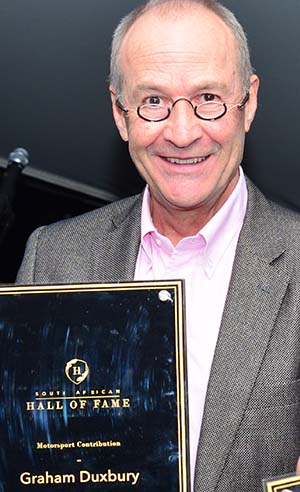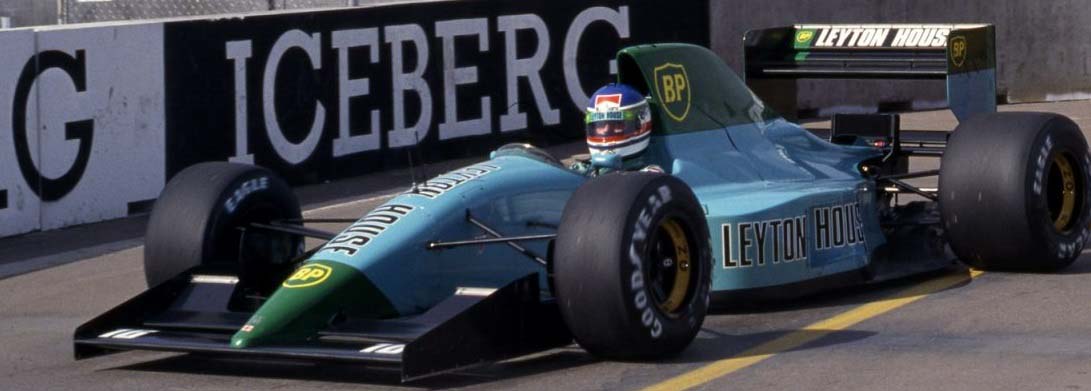A lifeline was thrown to the March Formula One team by Leyton House, a Japanese real estate company, which decided to sponsor the floundering team ahead of the 1987 season.
 By Graham Duxbury
By Graham Duxbury
The Leyton House brand was owned by Akira Akagi, a Korean, who, it is said, did little to dispel the perception that he was Japanese. Apparently, his motive for supporting a F1 team had to do with brand awareness in Japan where there is a large F1 following.
Incidentally, Leyton House was named after the London suburb of Leyton where Akagi had spent some time as a youngster.
Akagi’s infusion of cash came too late for March to design and develop a new car for 1987. So, an existing March 86B F3000 chassis was modified to accept a bigger fuel tank and a Cosworth DFZ V8 engine. This last-minute lash-up was named the March 87P.
At the first race of the season, the Brazilian Grand Prix, the 87P blew its engine in the warm-up session and did not start. Ivan Capelli would go on to score just one championship point all season with the uncompetitive March whose only virtue was a superb turquoise livery officially dubbed Miami Blue.
The gloomy atmosphere at the team was brightened mid-1987 with the arrival of Adrian Newey, a young 28-year-old technical director with a solid reputation garnered in America.
Newey set to work to design a new March F1 car powered by a naturally-aspirated Judd V8 engine for Capelli and teammate Mauricio Gugelmin to drive in 1988.
The car became known as the Leyton House 881 and the team Leyton House Racing ahead of the publicly-owned March company’s sale to Akagi in 1989.
Newey relished the challenge. Although he was offered a smaller salary (compared to his US stipend), he had prize money incentives written into his contract. His task was to achieve some degree of competitiveness against cars such as the all-conquering McLaren-Honda which was powered by a more powerful 1.5-litre V6 turbocharged engine.
Typically, Newey conscientiously studied the regulations and found some areas that could be exploited. For example, the 881 had a slim-line V-shaped chassis, the front of which had a raised and sculpted underside to improve airflow. This resulted in the driver’s feet being raised – a “first” for F1.
The driving position – common today – was akin to lying in the bath and imaging the taps as the accelerator and brake.
Other innovations included significant advances in chassis and front wing design with aerodynamic advantages at their core. Newey improved the downforce-to-drag ratio of the car to 3:1 when others were struggling to best the 2:1 mark.
“In terms of creating a package we had taken a huge step forward,” says Newey who was able to infuse this back-of-the-grid team with design expertise that led to real on-track successes.
For example, the 881 finished in a fine second place in the Portuguese GP with Capelli at the wheel. And it was also the only normally-aspirated powered car to lead a race all season when Capelli passed the McLaren-Honda of Alain Prost at the Japanese GP. This was the first time since 1983 that a naturally-aspirated car had led a GP. Unfortunately, retirement from the race soon followed.
The aerodynamics and ultra-slim monocoque of the 881 were copied by most of the grid in 1989 and the car launched Newey as the superstar designer we know today.
His is the only legacy that survived what was to become the Leyton House debacle.
Newey parted company with the team in 1990, under somewhat of a cloud after a disappointing ’89 season plagued by wind tunnel issues. Nevertheless, he describes the March-to-
Leyton House metamorphosis as “the breeding ground for the world championships that followed over the next two decades, and the ultimate success of Red Bull Racing”.
Soon afterwards, Akagi was implicated in a financial scandal. He was arrested and later incarcerated. The team was then sold to a consortium headed by the Dutch motorsport enthusiast Henny Vollenberg and reverted to the March name. Attempts to sell the team again in 1992 failed and it folded in early ‘93.
Akagi died on 8 August 2018. He was 73 years old.

Ivan Capelli in the uncompetitive Leyton House March whose only virtue was a superb turquoise livery officially dubbed Miami Blue.
Photocredit: racefans.net
